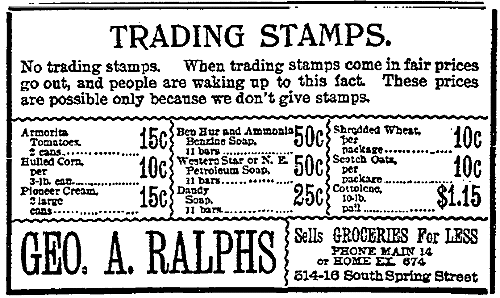
Thursday, September 27, 2007
Page 1
REMINISCING (Column)
M & M Takes Firm Stance Against Green Stamps
By ROGER M. GRACE
“We have branches in all cities of the United States and have over half a million dollars invested in our stocks. WE HAVE OPENED A PERMANENT BUSINESS IN LOS ANGELES AND ARE HERE TO STAY.”
Such was the proclamation of the Los Angeles Trading Stamp Company in a newspaper advertisement on July 21, 1898. The New York-based proprietors, Joseph A. Sperry and Shelly Hutchinson, were determined not to be thwarted by the Merchants’ and Manufacturers’ Assn., as a predecessor operation had been the year before.
Even as the new company started to set up shop here, the M & M Board of Directors on June 17 reaffirmed a resolution passed in November condemning the “trading-stamp scheme” and urging merchants not to participate in it.
For those too young to remember trading stamps…you would get them when you made a purchase from a retailer. The more money you spent, the more stamps you’d get. You would paste them into squares in a book, and when the book was filled, you could take it to a redemption center and trade it for merchandise. To get anything worthwhile, however, you would need multiple books.
That was how the system worked from the time in 1898 that Sperry and Hutchinson first opened their redemption center in Los Angeles at 326 S. Broadway. Their stamps were green—and would later be known as “S&H Green Stamps.”
In later years, only one seller of any given type of goods could carry green stamps in any community, thus affording a competitive advantage to the chosen merchant. That wasn’t so at first. A May 11, 1899 ad in the Los Angeles Times lists the businesses giving out the stamps; there were, for example, 29 grocers.
A grocer who didn’t participate was Hans Jevne, whose company occupied the current MetNews space in the Wilcox Building at Second and Spring—though a stationery store, an art store, and a dye works in the building did give stamps…and were no doubt not patronized by those going to and from M&M meetings, held in the group’s offices on the Second Floor.
Another grocer who refused to deal with Sperry and Hutchinson’s outfit was George A. Ralphs, whose July 5, 1904 ad in the Times says:
|
|
Ironically, in 1963, nearly a half-century after Ralphs’ 1914 death, Ralphs Grocery Company was among nine companies named in an antitrust complaint filed by the Justice Department in Los Angeles based on their operations of Blue Chip Stamp Company, which was competing with S&H.
On July 25, 1898, a Monday, the M & M board voted to ask the City Council to impose a $250 per month license fee on trading stamp companies. The next day, a proposed ordinance was presented to the city’s governing body and was referred to the Finance Committee. That committee considered the matter the next Friday.
It was not well received because the trading stamp business was a lawful one, and no merchant was compelled to deal with any such vendor of the stamps. The committee’s subsequent recommendation was negative, and the Council, without discussion, on Aug. 15 voted to receive and file the M & M’s recommendation.
Had the M & M’s proposal won favor in the City Council, the victory would have been short-lived in light of a soon-to-come California Supreme Court decision…a subject of next week’s column.
Resistance to the trading stamp plan by Jevne, Ralphs and other leading merchants was on sound footing. A business buying the stamps was required to pay the stamp company five percent of its gross profits. For the first company that signed up, the increase in sales would justify the expense. As more and more retailers signed up in order to compete, the increase in profits would recede, then fade, with the inevitable result being hiked prices. “Free” merchandise at a redemption center would, in truth, be anything but free; the consumer would have paid for it at the time of making a purchase at the store providing the stamps.
Once S&H limited the number of businesses in a geographical area that could offer its stamps, this prospect perished…only to become a reality once Blue Chip Stamps, which first appeared in 1956, became ubiquitous. Virtually every store that did not provide Green Stamps handed out Blue Chip Stamps…or double stamps…sometimes triple stamps.
As the M & M long before envisioned, retailers became slaves to the schemes. For a merchant, handling the stamps was a burden. To a consumer, it meant higher retail prices, the need to paste the stamps in booklets, and then make a special trip to a redemption center to secure something that was not desired to the extent of having purchased it from any of the retailers who had supplied the stamps.
Copyright 2007, Metropolitan News Company